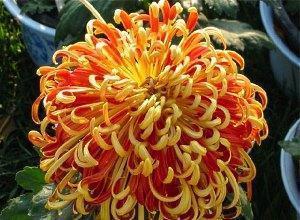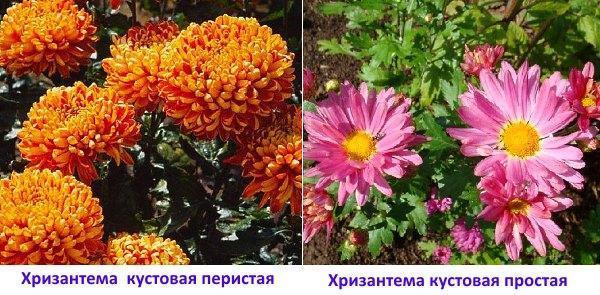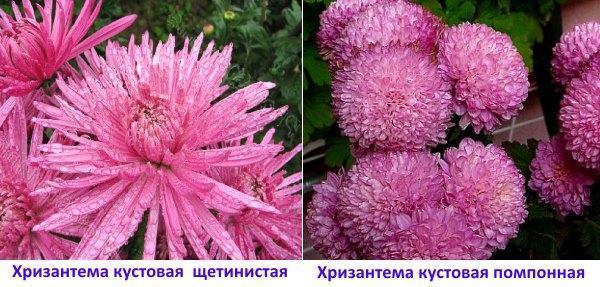Chrysanthemum bush - the queen of the flower garden
 All spring and summer, she hides in invisible bushes in the flower garden, unquestioningly giving primacy to the letniki. Walk past her and not look. Behind the exuberant bloom of roses, dahlias, aquilegias, chamomiles, mallow and levkoev lies a modest princess in her inconspicuous attire. But, with the onset of autumn, when the colors of summer have faded, the flowers in the flowerbed have withered, withered and faded, the queen of autumn, chrysanthemum, comes into its own. With bright spots of paints scattered here and there, it now attracts the eye and pleases us until the very frost.
All spring and summer, she hides in invisible bushes in the flower garden, unquestioningly giving primacy to the letniki. Walk past her and not look. Behind the exuberant bloom of roses, dahlias, aquilegias, chamomiles, mallow and levkoev lies a modest princess in her inconspicuous attire. But, with the onset of autumn, when the colors of summer have faded, the flowers in the flowerbed have withered, withered and faded, the queen of autumn, chrysanthemum, comes into its own. With bright spots of paints scattered here and there, it now attracts the eye and pleases us until the very frost.
The homeland of chrysanthemum is the Far East, where people have been cultivating it since ancient times. Since ancient times, the Chinese began to decorate their gardens with chrysanthemums. However, preference was given to the large-flowered potted chrysanthemums. This plant was a versatile means for decorating flower beds and living quarters.
Later, in the 6th century, chrysanthemum migrated from China to Japan, where the cultivation of this type of flowers acquired its own distinctive culture. Chrysanthemums, which have retained their original appearance, are especially worshiped in Japan. These varieties are grown in temple gardens and are part of the national culture. Chrysanthemum for the Japanese is a symbol of longevity, moreover, it was honored to become the emblem of the land of the rising sun.
In 1789, the chrysanthemum culture spread westward to Europe. The Europeans, in their characteristic manner, spread this wonderful plant species and knowledge of its cultivation methods throughout the continent. True, now preference was given to bush varieties of chrysanthemums. An interesting fact is that the fashion for growing bush chrysanthemums has returned to Japan. Now the traditional culture of growing large-flowered chrysanthemums is fighting there with the newfangled culture of growing bush chrysanthemums.
Bush chrysanthemum varieties
Today we know about 650 varieties of chrysanthemums. The most popular types of spray chrysanthemums are:
1. Chrysanthemums are feathery, with double flowers, and the petals completely hide the middle of the flower;
2. Non-double chrysanthemums - flowers resemble chamomile, they are flat flowers with an open middle, with single or several rows of petals;

3. Chrysanthemums bristly or thistle, very similar to feathery, but with thinner petals
4. Pompon chrysanthemums, practical round in shape, with small double inflorescences;

5. Chrysanthemums are anemone, resemble semi-double ones, but have a convex middle.
6. Chrysanthemums are spoon-shaped, the flower petals of which at the tips expand, resembling a spoon in shape.

7. Fantasy chrysanthemums, a new variety developed in Japan. Practically, these are feathery chrysanthemums, but with more elongated petals.
8. Korean chrysanthemums (oak) stand out as a special group of cold-resistant bush chrysanthemums. This group of chrysanthemums tolerates cold well, which makes them popular in cold regions. They are able to winter outdoors under cover.

Care
Bush chrysanthemum is a light-loving plant. It is desirable to plant in the southern part of the flower garden.
Shrub chrysanthemum prefers nutritious, loose soil. Low-fertile soil should be fertilized with rotted manure or peat, but do not abuse them, otherwise the bush will begin to actively increase the green mass, and flowering will slow down.
Chrysanthemum is planted on a cloudy day. After planting the bush in the ground, pinch the bush - while significantly shortening all the stems. After 3 weeks after planting, pinch the bush again, breaking out the upper part of the stems with 2-3 nodes.
The first enemy of bush chrysanthemum is excess moisture. Soaking the root system leads to its decay. Therefore, the bush should be planted in spring on a slightly raised area. Water the plant sparingly, but regularly. It is recommended to use soft water (settled or rainwater) for irrigation.
During particularly hot days, you should pay special attention to it. The delicate foliage of the chrysanthemum can "burn", which will have a very negative effect on future flowering. It will just be enough during this period to increase watering frequency and slightly shade the bush from hot rays.
It is very useful to apply fertilizers, alternating organic with mineral fertilizers. Organic fertilizer is prepared as follows. Pour a bucket of mullein with 3 buckets of water and let it brew for three days. Next, dilute 1 liter of infusion with 10 liters of water. Stir thoroughly and add 1 liter to the root of the bush. solution. the procedure should preferably be done during the rain or immediately after it, so that the soil is moist.
To activate the growth of the bush, nitrogen fertilizers are added, and during the budding period - phosphorus and potassium fertilizers. As soon as the flowering of the bush begins, the plant no longer needs feeding.
Further care of the bush chrysanthemum is not difficult. It is enough to regularly water, loosen the soil, weed the weeds.
Juicy tender tops of bush chrysanthemums are a delicacy for aphids. In order not to let her roam, it is necessary to spray the bush with the solution "Aktofit" or "Ratibor". The procedure must be carried out 2-3 times per season.